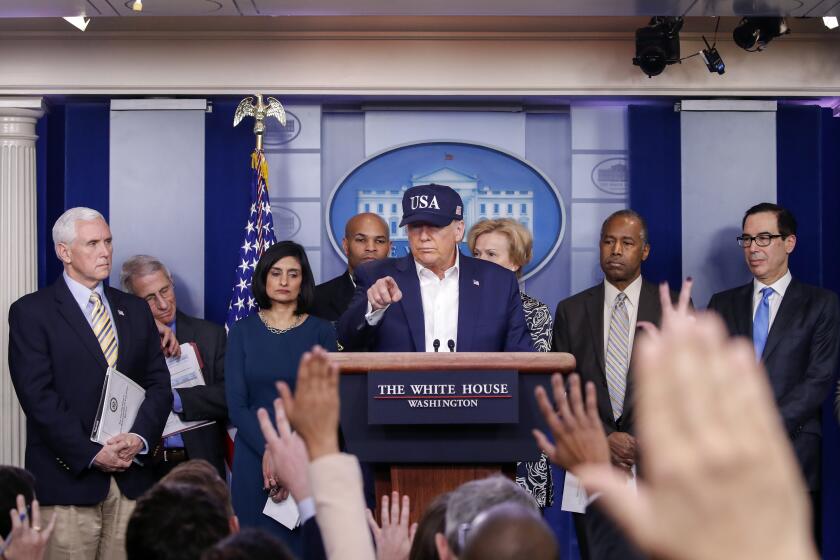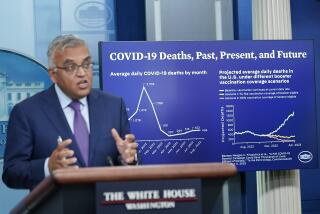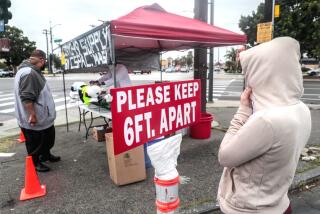Column: We shut down the economy to make progress against COVID-19 — and then made no progress

- Share via
Another Thursday, another dismal unemployment statistic. This time the Department of Labor is reporting that 2.98 million Americans filed initial unemployment claims in the last week.
That brings total filings over the last eight weeks to 36.5 million people. The latest figure was both mildly heartening and fairly disheartening. It marks an improvement over last week, when initial claims were 3.17 million, and a steady improvement since the peak in new filings of 6.6 million was announced April 2.
On the other hand, the figure still exceeded the expectations of some economists, which were as low as 2.5 million. As has happened every week since the end of March, the number prompted fretful commentary about the breadth of the damage from COVID-19 — or more precisely, from the nationwide stay-at-home lockdown aimed at stemming the spread of the disease.
#StayHome had its moment. But quarantine fatigue is real.
— Julia Marcus, The Atlantic
The number also provides context for two signals about the American response to the coronavirus pandemic. One is that many people are getting fed up with the lockdown, and not only because it throws millions of them out of work, whether temporarily or for the long term. The other is that we have made scant progress against the virus, or at least not nearly as much as the richest, most powerful and most technically adept nation on Earth should have made.
The two indicators are related. One source of discontent with the shutdown is the broken promise that it would give the country time to put in place a program to successfully fight the virus. Without a program of testing and screening to identify viral hot spots and institute selective quarantines, the general public has learned it faces many months more of work, travel and recreational constraints.
The impulse to return to normality is fighting an increasingly tense battle with advice to maintain social isolation.
In Senate testimony this week, Dr. Anthony Fauci, the nation’s most credible scientific voice in the crisis, warned that states that reopen businesses and allow public gatherings too hastily while the pandemic is still in full cry could “trigger an outbreak that you may not be able to control. ... If you think we have it completely under control, we don’t. The consequences could be really serious.”
By removing unemployment benefits, states are forcing workers to risk their lives
That triggered a pushback from President Trump, the nation’s leading avatar of crisis pseudoscience, who called Fauci’s position “not an acceptable answer.”
Here’s the counterfactual. If clear progress were being made in testing and screening and clearly consistent rules were being promoted across the board, then the current shutdown would be much easier for most people to bear. That’s always the case when one can see a light at the end of the tunnel.
Let’s examine how these two phenomena — the lack of an acceptable anti-virus program, and the urge to reopen — remain in tension.
As I’ve observed before, the Trump administration has only limited power to reopen the economy. Trump can order certain industries to reopen their factories. This works best when he can credibly designate them as essential and when their bosses don’t care much about the consequences of their working conditions on the health of their employees, as is the case in meatpacking.
It also can work where governors and local officials are content to connive with local employers to coerce employees into returning to work. The most popular tool appears to be withholding unemployment benefits from those who would stay home out of fear for their health or the necessity of caring for sick family members. (Thank you, Iowa, Texas and Ohio.)
The problem is that consumers can’t be coerced into the marketplace. As Jordan Weissmann observed in Slate, patrons have so far been reluctant to pile back into sit-down restaurants in great numbers even in the most aggressively reopened states.
That’s according to data from the restaurant booking service Open Table, which finds that as of Wednesday, even in open states reservations and walk-ins were still down by about 85% to 70% from the pre-pandemic era. The best record was in Alabama, which never fully shut down, where patronage was only 77.5% of the pre-crisis baseline.
Don’t be fooled by anti-shutdown demonstrations at statehouses such as Michigan’s by gun-toting goons, or by the decision by the right-wing majority on the Wisconsin Supreme Court to overturn that state’s stay-at-home rules, or by news photos of diners sitting cheek by jowl in a few reopened eateries and bars.
Workers crammed virtually shoulder-to-shoulder to tend production lines moving at inexorable speeds, high rates of disease and injury, low pay and unforgiving rules on time off or meal and bathroom breaks. Descriptions of today’s meatpacking industry sound lifted from Upton Sinclair.
The figures from Open Table, combined with opinion polls, indicate that the vast majority of Americans still favor keeping businesses closed to combat the coronavirus.
In a recent Washington Post-Ipsos poll, for example, 79% of laid-off respondents favored continuing to fight the virus’ spread “even if that means keeping many businesses closed.” That was a higher figure than all respondents, who favored maintaining the shutdown by 74% to 25%.
In other words, a majority of Americans are still voting with their feet, or to put it indelicately, with their behinds on the couch, to keep infection-prone businesses closed.
It’s true, however, that signs are emerging that Americans are getting fed up with restrictions that seem unnecessarily stringent. Some evidence comes from a mobility database assembled by Apple from requests for driving, walking and transit directions made to its Apple Maps app. (Apple says the data are aggregated to preserve user privacy and it doesn’t keep records of individual travels.)
The data indicate that Americans stopped moving around in early to mid-March, when direction searches abruptly fell by more than 60% from the baseline and bottomed out at a reduction of about 70% in the first half of April. Since then, however, searches have measurably picked up, with searches for walking routes down by only 39% and for driving directions by 40% as of May 10.
Searches involving transit, however, have remained mired at negative 77%. That’s unsurprising, since a reduction in commuting will keep workers off buses and trains, and any residual ridership might be stifled by concerns about sharing trips with strangers.
That’s one sign of exasperation with the shutdown.
“#StayHome had its moment,” Harvard epidemiologist Julia Marcus writes in the Atlantic. “But quarantine fatigue is real.” She emphasizes the effect of emotional isolation, which can “severely damage psychological well-being, especially for people who were already depressed or anxious before the crisis started.” In a recent poll by the Kaiser Family Foundation, 45% of respondents said the pandemic has harmed their mental health.
Plainly it’s the open-ended nature of the lockdown that‘s weighing on Americans. In the same poll, published on April 2, some 74% of respondents said “the worst is yet to come.”
That’s where the Trump administration deserves the greatest blame. The pathway to crushing the pandemic in the United States by early summer was never much in doubt.
As public health expert Harvey V. Fineberg laid it out in early April, it required establishing a unified command with indisputable authority to mobilize every public and private resource for the war against the virus. The nation would have to gear up to perform millions of diagnostic tests by mid-April and establish a system of disease surveillance and quarantine of infected or at-risk individuals.
A public health expert shares how to crush the virus. But we’re way behind.
Most important, the American public, resistant to government regimentation even in a crisis, would have to be shown how shared action and shared sacrifice would defeat the virus. Any such intrusive system would require credible leadership to “inspire and mobilize the public,” Fineberg said.
Trump has accomplished none of those things. Management of the coronavirus response at the White House and throughout the federal government has given new meaning to the word “chaos.” No one knows who’s in charge of what, the government has broken up into fiefdoms engaged in internecine battles, and the only person known to have Trump’s ear is his son-in-law Jared Kushner, who has demonstrated incompetence at every turn, compounded by arrogance.
Trump vacillates between urging caution in reopening the economy and encouraging rabble-rousing gangs fighting lockdowns. He seems to think that saying something is so is the same as making it happen, as was evident when he promised that anyone in America could get a COVID-19 test on demand, then promised that drive-up testing stands would be in existence around the country in short order. That was on March 13. It still hasn’t happened.
As Keith Humphreys of Stanford University points out, the obstacles to mounting a nationwide “test, trace, and isolate program” aren’t technical — Germany and South Korea have managed to do so. The challenges are political and cultural in a country that has been trained since the Reagan administration to mistrust the government.
That particular chicken has come home to roost. At a moment when a consistent, humanistic expression of government authority would save thousands of lives, federal leadership is in the hands of a petulant egotist whose interest appears to be in using this crisis to divide Americans, not unite them in a shared cause, and blame everyone else for his own manifest failure.
Trump is getting what he seems to want: a nation mired in a chaos that benefits only those with the means to insulate themselves from the crisis. The rest of us can do nothing but gnash our teeth at a shutdown without end, amen.
More to Read
Inside the business of entertainment
The Wide Shot brings you news, analysis and insights on everything from streaming wars to production — and what it all means for the future.
You may occasionally receive promotional content from the Los Angeles Times.














